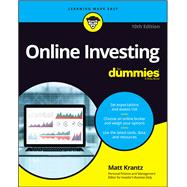Build a winning portfolio—and reduce your risk—with this bestselling guide
Online investing has never been easier—or more potentially confusing. Now that every broker or finance site has its own app, data, or approach, it can be all too easy to be misled and make a bad decision. Online Investing for Dummies helps you reduce risk and separate the gimmicks from the gold, pointing investors of all experience levels to the pro-tips, calculators, databases, useful sites, and peer communities that will lead to success.
Updated to include information on mobile trading and the influence of social media on the markets, the book also covers the basics—showing you how to figure out how much to invest, find data online, and pick an online broker. It then progresses through to more advanced topics, such as calculating returns, selecting mutual funds, buying bonds, options, commodities, and IPOs, taking you and your money wherever you want to go in the global market.
- Set expectations and assess your risk
- Analyze stocks and financial statements
- Assemble the suite of tools to calculate your performance
- Get tips on choosing the right online broker and on protecting your information online
It’s time to get a pro strategy, and Online Investing for Dummies has all the inside information you need to build up that winning portfolio.








